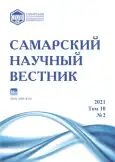Biodiversity of vertebrates on the territory of deforestation in the Vologda Region
- Authors: Pilipko E.N.1, Dvornikov M.G.2, Bulakhov V.L.3
-
Affiliations:
- Vologda State Dairy Farming Academy by N.V. Vereshchagin
- Professor Zhitkov Russian Research Institute of Game Management and Fur Farming
- Oles Honchar Dnepropetrovsk National University
- Issue: Vol 10, No 2 (2021)
- Pages: 72-77
- Section: General Biology
- URL: https://journals.rcsi.science/2309-4370/article/view/78098
- DOI: https://doi.org/10.17816/snv2021102110
- ID: 78098
Cite item
Full Text
Abstract
The paper presents the results of biodiversity assessment on the territories with different ecological conditions. The studies were carried out on the territories during the reforestation period after the anthropogenic load associated with deforestation, as test sites (PP) and forest biogeocenoses adjacent to deforestation and not affected by forestry activities – control (K). The research methods are indicated. The Jacquard and Stugren-Radulescu coefficients, as well as the Sorensen-Chekanovsky and Kulchinsky indices were used to assess the biodiversity. During the survey of the territories, 32 species of animals were found: 1 species belongs to the class of amphibians, 5 – reptiles, 13 – birds and 13 – mammals. The list of the faunal composition of the studied territories is given. As a result of the conducted studies it has been revealed that the qualitative and quantitative characteristics of the faunal composition directly depend on the derived type of forest, the method of deforestation and the environmental conditions prevailing on this territory. Of the territories considered, the greatest faunal diversity (19 species) was observed on the territories with 12-year-old-cut-down forest, with moderately moist soils and predominant floristic diversity. Based on the calculation of the indices and coefficients of similarity and difference, the similarity of the species faunal diversity has been revealed on the territories of mixed-grass and blue joint fellings as well as in the control areas of lingonberry pine. The difference from all the sample areas has been revealed in the meadowsweet felling (PP1) and the adjacent forest biogeocenosis – grass-marsh pine forest.
Full Text
##article.viewOnOriginalSite##About the authors
Elena Nikolaevna Pilipko
Vologda State Dairy Farming Academy by N.V. Vereshchagin
Email: karlovna@ukr.net
candidate of biological sciences, associate professor of Forestry Department
Russian Federation, VologdaMikhail Grigorevich Dvornikov
Professor Zhitkov Russian Research Institute of Game Management and Fur Farming
Email: dvornikov50@mail.ru
doctor of biological sciences, professor, leading researcher of Hunting Resource Studies Department
Russian Federation, KirovValentin Leontievich Bulakhov
Oles Honchar Dnepropetrovsk National University
Author for correspondence.
Email: zoolog@i.ua
candidate of biological sciences, professor of Zoology and Ecology Department
Ukraine, DnepropetrovskReferences
- Животный мир Вологодской области: материал к беседе / под ред. Т.Н. Малышевой, Е.Б. Резванцева, И.В. Галахова, Н.Б. Шпагина. Вологда, 2013. 18 с.
- Шабунов А.А., Болотова Н.Л., Коновалов А.Ф., Филоненко И.В. Позвоночные животные // Природа Вологодской области. Вологда: Изд. дом Вологжанин, 2007. С. 271–286.
- Коновалов А.Ф. Млекопитающие Вологодской области (справочник-определитель): учеб. пособие. Вологда: ВГПУ, изд-во «Русь», 2005. 157 с.
- Исаев А.С., Носова Л.М., Пузаченко Ю.Г. Биологическое разнообразие лесов России // Биологическое разнообразие лесных экосистем: сб. ст. по мат-лам всерос. совещ., Москва, ноябрь 1995 г. М.: Межд. ин-т леса, 1995. С. 3–10.
- Залепухин В.В. Теоретические аспекты биоразнообразия: учеб. пособие. Волгоград: ВолГУ, 2003. 192 с.
- Эшби У.Р. Введение в кибернетику. М.: Мир, 1966. 432 с.
- Пригожин И., Стенгерс И. Порядок из хаоса: Новый диалог человека с природой. М.: Прогресс, 1986. 432 с.
- Пузаченко Ю.Г. Экосистемы в критических состояниях. М.: Наука, 1989. 155 с.
- Абатуров А.В., Меланхолин П.Н. Опыт рубок ухода в березняках I группы: Лесопользование в лесах различной категории защитности. М.: Минлеспром, 1991. 134 с.
- Меланхолин П.Н. Изменение биоразнообразия в нижнем ярусе березняка после рубок ухода // Биологическое разнообразие лесных экосистем: тез. докл. всерос. совещ. М., 1995. С. 279–280.
- Меланхолин П.Н. Изменение видового разнообразия травяно-кустарничкового яруса при различных антропогенных нагрузках на лесные экосистемы // Лесоведение. 2006. № 6. С. 52–58.
- Бурова Н.В., Торбик Д.Н., Феклистов П.А. Изменение флористического разнообразия после выборочных рубок в ельниках черничных // Лесной вестник. 2010. № 5. С. 49–51.
- Новиков Г.А. Полевые исследования экологии наземных позвоночных животных. М.: Советская наука, 1949. 321 с.
- Формозов А.Н. Звери, птицы и их взаимосвязи со средой обитания. М.: Наука, 1976. 309 с.
- Формозов А.Н. Спутник следопыта. М.: Изд-во Московского университета, 1989. 189 с.
- Ошмарин П.Г., Пикунов Д.Г. Следы в природе. М.: Наука, 1990. 260 с.
- Коновалов А.Ф. Определитель млекопитающих Вологодской области. Вологда: Легия, 1999. 140 с.
- Приедниекс Я. Сравнительный анализ метода учетов птиц во время гнездового сезона // Сообщ. ХХ Прибалт. комиссии по изучению миграций птиц. Тарту, 1990. С. 42–57.
- Мак Дайермид Р.В., Хэйек Л.Э., Крамп М.Л. и др. Измерение и мониторинг биологического разнообразия: стандартные методы для земноводных / ред. В.Р. Хейер; пер. с англ. С.М. Ляпкова. М.: Изд-во КМК, 2003. 380 с.
- Наумов Н.П. Изучение подвижности и численности мелких млекопитающих с помощью ловчих канавок // Вопросы краевой, общей и экспериментальной паразитологии и медицинской зоологии. М.: Наука, 1955. С. 179–202.
- Карасева Е.В., Телицына А.Ю. Методы изучения грызунов в полевых условиях. М.: Наука, 1996. 416 с.
- Раль Ю.М. Некоторые методы экологического учета грызунов // Вопросы экологии и биоценологии. Вып. 3. Л.: Биомедгиз, 1936. 76 с.
- Булахов В.Л., Губкин А.А., Мясоедова О.М. Методические указания по количественному учету позвоночных животных на производственной практике. Днепропетровск: ДГУ, 1986. 52 с.
- Карпочевский М.Л., Тепляков В.К., Яницкая Т.О., Ярошенко А.Ю. Основы устойчивого лесоуправления: учеб. пособие для вузов. М., 2009. 143 с.
- Лебедева Н.В., Дроздов Н.Н., Криволуцкий Д.А. Биологическое разнообразие: учеб. пособие для студ. высш. учеб. заведений. М.: Владос, 2004. 432 с.
- Lindenmayer D.B., Margules C.R., Botkin D.B. Indicators of biodiversity for ecologically sustainable forest management // Conservation Biology. 2000. Vol. 14, № 4. P. 941–950.
- Newton A.C., Kapos V. Biodiversity indicators in natural forest inventories // Unasylva. 2002. Vol. 53, № 210. P. 56–64.
Supplementary files







